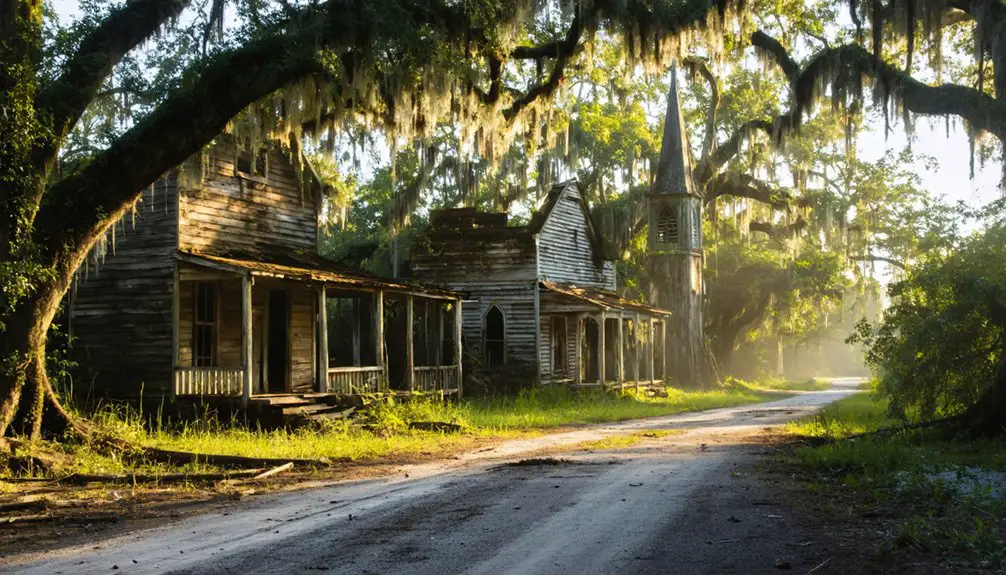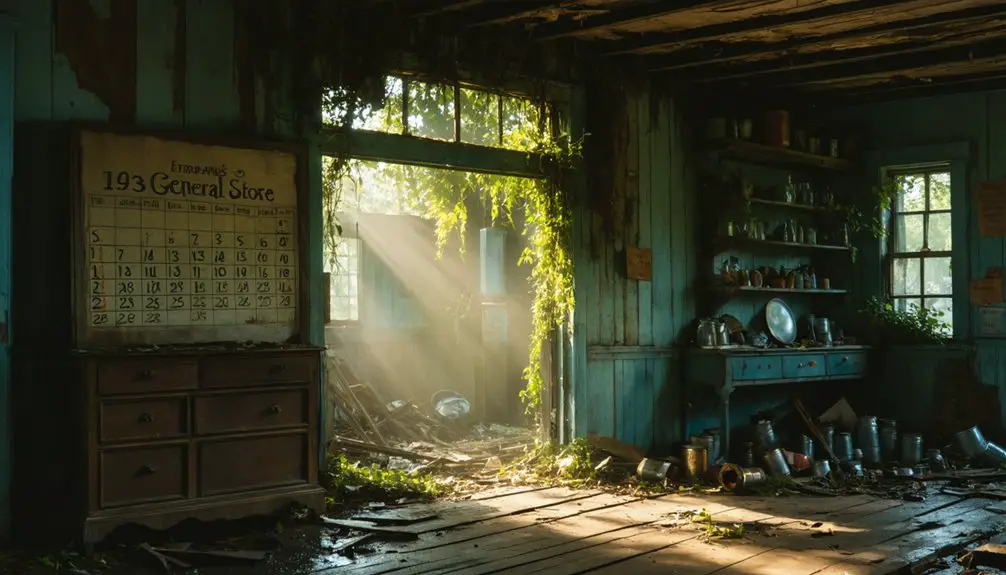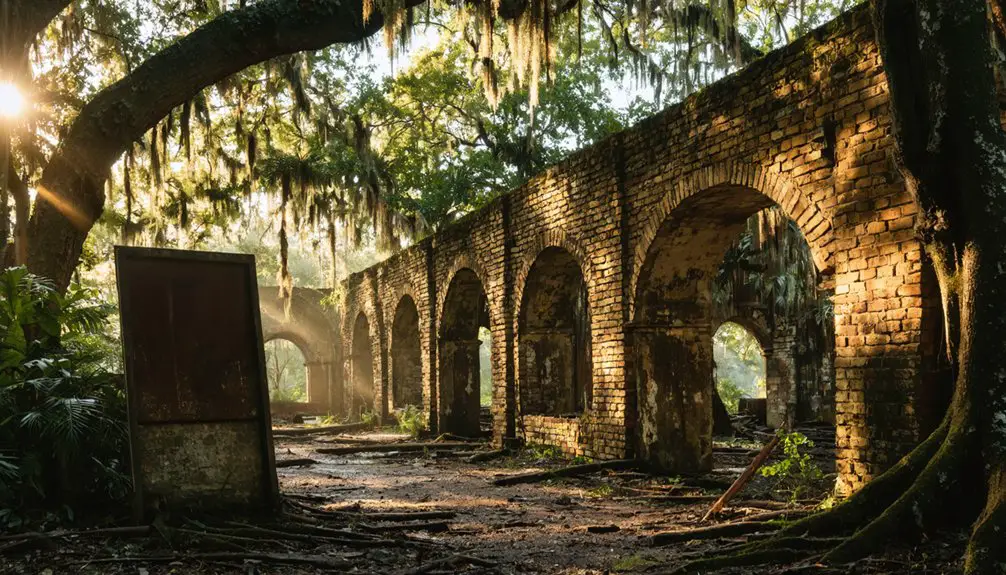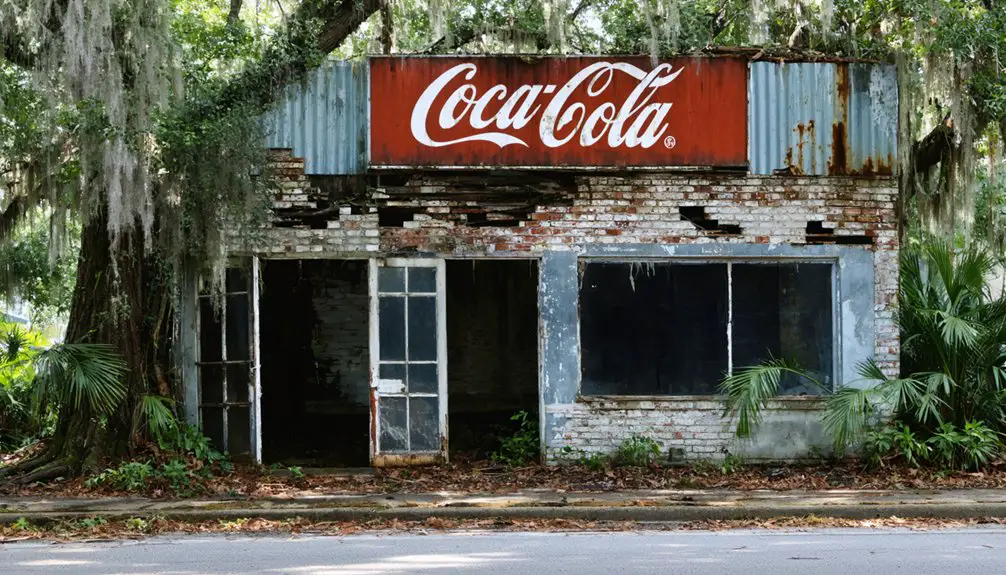You’ll discover Saint Catherine nestled along Florida’s St. Johns River, a ghost town that flourished in the early 1900s as a bustling lumber community. The town’s heart beat around its sawmills, processing ancient cypress logs while supporting thirty-five stores during its peak. Natural disasters, including a devastating 1898 mill fire and three major floods between 1994-2004, ultimately led to its abandonment. The ruins hold countless stories of frontier life, economic booms, and the town’s eventual decline.
Key Takeaways
- Saint Catherine began as a Spanish missionary outpost in the 1600s and later became a thriving lumber town along Florida’s St. Johns River.
- The town’s economic decline began with a devastating sawmill fire in 1898, destroying its primary source of employment and commerce.
- Three major floods between 1994-2004 destroyed 70% of housing, leading to widespread abandonment and the town’s ghost status.
- The Florida Sanitarium, established in 1908, briefly revitalized the area as a health tourism destination before eventual decline.
- The site now stands as a historical reminder of Florida’s industrial past, with remaining structures and local legends attracting explorers.
The Rise of a Frontier Settlement

As Spanish missionaries ventured into Florida’s interior during the early 17th century, the area that would become Saint Catherine emerged as a strategic settlement near the St. Johns River.
Early Spanish missionaries established Saint Catherine as a vital outpost along Florida’s St. Johns River in the 1600s.
You’ll find the roots of this frontier community in the Catholic missions, particularly Santa Catalina de Afucia, which served as an early anchor for European presence in the region.
The settlement’s growth faced numerous frontier challenges, from clearing dense wetlands to battling diseases and floods.
Early settlers developed pragmatic settlement strategies, choosing locations near the river for transportation while establishing small farms on fertile soil. Like busy river ports of the era such as Rodney, Mississippi, Saint Catherine relied heavily on waterway access for its economic growth.
They’d gradually transform isolated homesteads into a proper community, complete with a mission church on donated land.
The river’s proximity proved vital, enabling trade and communication with other settlements despite the harsh frontier conditions. Fresh drinking water was scarce in the region, with settlers primarily relying on limestone basins for their water supply.
Life in Saint Catherine’s Golden Era
The rhythmic hum of sawmills defined Saint Catherine’s golden era during the early 20th century, when the town thrived as a bustling lumber community.
You’d find workers starting their days early, heading to the mill where ancient cypress logs awaited processing. Similar to the United Empire Loyalists who first settled the area, these workers were pioneers in their own right. The town’s life centered around the sawmill’s demanding schedule, with workers living in simple wooden homes nearby for convenience. Just like modern keyboard shortcuts enhance navigation, the mill workers developed efficient routines to maximize their productivity.
Community gatherings often took place at the boarding houses, where you’d meet timber cutters and mill operators sharing stories after their daily routines. The general store served as another social hub, while work-related meetings brought folks together regularly.
Despite the physically demanding nature of sawmill work, you’d witness a tight-knit community where residents supported each other through floods and other challenges of frontier life.
Economic Foundations and Commerce
Saint Catherine’s economic foundation rested on a complex web of agricultural and industrial ventures, with cotton serving as the region’s primary economic engine. You’d find thousands of cotton bales moving through the area’s bustling ports, supporting a network of merchants, craftsmen, and shipping specialists who kept commerce flowing smoothly along the waterways.
The town’s economic drivers extended beyond cotton production to include resource extraction and secondary industries. You’d see lumber operations, turpentine harvesting, and phosphate mining contributing to the local economy, while banks, hotels, and diverse retail establishments served both residents and travelers. Similar to Rodney, Mississippi, the town supported thirty-five stores during its peak period. Like many Florida settlements affected by the boom-bust cycles, Saint Catherine experienced periods of rapid growth followed by economic decline.
This commerce evolution created a vibrant marketplace where steamboats regularly docked, loading cargo and connecting Saint Catherine to major trading networks throughout the region.
The Sanitarium’s Health Tourism Legacy
The Florida Sanitarium’s early health tourism marketing centered on the region’s healing climate and fresh air, which you’d find promoted heavily in their 1910s advertisements targeting Northern visitors seeking relief from tuberculosis and respiratory ailments.
You’ll notice their strategic emphasis on Saint Catherine’s natural springs and pristine water sources, which they claimed held therapeutic properties similar to famous European spa destinations. Similar to Mission Santa Catalina de Guale, Saint Catherine attracted visitors seeking spiritual and physical healing through its natural resources.
The sanitarium’s promise of combining Florida’s subtropical climate with Battle Creek’s proven health methods helped establish Saint Catherine as an early 20th-century wellness destination, drawing wealthy health tourists from across the Eastern seaboard. Founded by Dr. W. K. Kellogg in 1908, the facility began with just 20 beds and four patients seeking tuberculosis treatment.
Healing Waters Marketing Strategy
Marketing pioneers at Florida Sanitarium crafted a distinctive health tourism brand that seamlessly blended natural healing with luxury hospitality.
You’d have found their healing waters strategy woven into every aspect of the guest experience, from the wrap-around porches providing nature access to elegant dining rooms with crisp linen tablecloths.
Positioned strategically between two lakes, the facility provided an ideal setting for guests seeking therapeutic respite and rejuvenation. Like the stone statue unveiled at St. Catherine’s West, the property’s architectural features served as visual reminders of healing and hope.
Climate-Based Treatment Promises
Located between Lakes Estelle and Winyah, Florida Sanitarium’s climate-based treatment program promised healing through nature’s finest elements – fresh air, abundant sunshine, and therapeutic waters.
You’d find yourself immersed in climate therapies that capitalized on the region’s year-round warmth, with cool summers and mild winters supporting outdoor recovery. The sanitarium’s physicians prescribed “water cures,” combining lake bathing with carefully monitored exercise routines.
These healing environments reflected early 1900s health tourism trends, where urban dwellers sought refuge from industrial cities. Operating as a charitable nonprofit, the sanitarium made these natural treatments accessible to many, while medical oversight guaranteed professional care.
Though modern medicine eventually shifted away from climate-based healing, the sanitarium’s legacy lives on in Florida’s healthcare system, reminding us of nature’s role in recovery.
Natural Disasters and Economic Setbacks

You’ll find Saint Catherine’s fate was heavily shaped by the devastating 1898 mill fire that destroyed the town’s economic cornerstone, leading to widespread unemployment and outmigration.
The town’s recurring flood problems compounded these challenges by damaging essential infrastructure, disrupting transportation routes, and deterring new settlement or investment.
These natural disasters, paired with Saint Catherine’s dangerous overreliance on the lumber industry, created insurmountable setbacks that the town couldn’t overcome, especially as the Great Depression took hold.
Flood Damage Impact Analysis
Three major flood events between 1994 and 2004 devastated Saint Catherine and the surrounding Lake County region, marking a pattern of recurring natural disasters that contributed to the area’s eventual decline.
Despite community recovery efforts, the floods repeatedly damaged local infrastructure and housing, overwhelming the area’s flood resilience strategies.
You’ll find the devastating impact reflected in these key damages:
- Up to 70% of regional housing stock suffered severe structural damage, mirroring destruction patterns seen in comparable flood-prone communities.
- Agricultural lands experienced significant soil degradation and crop losses, crippling the local farming economy.
- Road and utility infrastructure failures isolated the community, leading to extended recovery periods and population displacement.
The economic burden of repairs, combined with rising insurance costs, ultimately proved insurmountable for this small Florida community.
Mill Fire Economic Fallout
While the region had already weathered significant challenges, a devastating mill fire in 1997 dealt Saint Catherine’s economy its most severe blow, triggering a cascade of economic setbacks that would accelerate the town’s decline.
You’d have seen the immediate impact as the timber industry, the town’s economic backbone, suffered hundreds of millions in losses. Local businesses couldn’t sustain operations as gross retail sales plummeted and tourism dried up.
The fire’s destruction extended beyond the mill itself, damaging critical infrastructure and disrupting regional supply chains.
The workforce faced unprecedented hardship as unemployment soared and skilled workers left the area. Without its primary industry, Saint Catherine struggled to maintain basic services, and the limited economic diversity left few options for recovery.
Secondary businesses soon followed the mill’s closure, creating a downward spiral the community couldn’t escape.
The Path to Abandonment
Through a series of devastating setbacks in the late 19th and early 20th centuries, Saint Catherine’s decline from a thriving industrial town to abandonment exemplifies the vulnerability of single-industry communities.
The industrial decline began with the catastrophic sawmill fire of 1898, triggering a chain reaction of economic hardship and community fragmentation that would prove insurmountable.
You’ll find the town’s path to abandonment marked by three essential factors:
- Recurring floods that destroyed infrastructure and deterred reinvestment
- Loss of transportation connections that isolated the community from crucial markets
- The Great Depression’s final blow to an already weakened economy
Cultural Heritage and Local Legends

As the physical remnants of Saint Catherine fade into Florida’s landscape, the town’s cultural heritage lives on through a rich tapestry of local legends and historical narratives.
You’ll find its cultural significance deeply rooted in Florida’s industrial past, where the sawmill industry once promised prosperity but ultimately surrendered to natural disasters and economic hardship.
Local residents have passed down tales of ghostly encounters near the old mill site, where unexplained noises and apparitions are said to echo the tragic 1898 fire.
The town’s haunting legacy intertwines with broader themes of environmental respect and industrial decline.
While you won’t find many standing structures today, Saint Catherine’s story reflects a vital chapter in Florida’s development, serving as a powerful reminder of how boom-and-bust cycles shaped the state’s rural communities.
Exploring Saint Catherine Today
Today, visiting Saint Catherine requires careful planning and a spirit of adventure. As you explore this fascinating ghost town, you’ll find yourself surrounded by the remnants of Florida’s past, where nature steadily reclaims abandoned structures and forgotten pathways.
For safe ghost town exploration, consider these essential points:
- Bring sturdy footwear and protective gear, as deteriorating buildings and overgrown vegetation pose potential hazards
- Pack plenty of water and emergency supplies, since you’re venturing into a remote area with limited services
- Document your discoveries through photography, but respect any historical preservation barriers or restricted areas
You’ll need your own transportation to reach the site, and it’s wise to inform others of your plans.
Weather conditions can change quickly in Florida, so timing your visit during cooler, drier months will enhance your experience.
Frequently Asked Questions
What Was the Population of Saint Catherine at Its Peak?
You’ll find ghost town demographics difficult to pinpoint, but based on regional patterns and population decline trends, Saint Catherine likely peaked at 100-200 residents before its eventual abandonment.
Are There Any Known Photographs of Saint Catherine During Its Existence?
You won’t find any confirmed historic imagery or photographic evidence from Saint Catherine. Despite research into regional archives and historical collections, no known photos have survived to document its existence.
What Happened to the Residents After They Abandoned the Town?
You’ll find residents scattered across Central Florida and neighboring states, seeking jobs in agriculture and industry. Their life after Saint Catherine shaped the town legacy through oral histories and family memories.
Were Any Notable Historical Figures Connected to Saint Catherine?
You won’t find any presidents or movie stars here! While Press Ogelsby’s Native American connections and Bill Dreggors’ historical research offer ghostly legends, Saint Catherine’s most notable figures were everyday pioneers and settlers.
Has Any Archaeological Excavation Been Conducted at the Saint Catherine Site?
Yes, you’ll find extensive archaeological excavations were conducted using modern methods like remote sensing and test pits, revealing Spanish mission structures, hundreds of burials, and artifacts from colonial-era daily life.
References
- https://myniagaraonline.com/blog/unveiling-the-history-of-a-ghost-town-in-st-catharines/
- https://floridanature.wordpress.com/2008/10/19/hunting-for-a-ghost-town-in-the-forest/
- https://www.tiktok.com/@socialshepherdadventures/video/7342301852702100778
- https://en.wikipedia.org/wiki/List_of_ghost_towns_in_Florida
- https://www.wikiwand.com/en/articles/List_of_ghost_towns_in_Florida
- https://mississippifolklife.org/articles/haunted-by-a-ghost-town-the-lure-of-rodney-mississippi
- https://en.wikipedia.org/wiki/History_of_Florida
- https://stcatherineop.com/about-us/our-parish-history/
- https://www.youtube.com/watch?v=TxBONhwNi1k
- https://www.suwgov.org/history/



